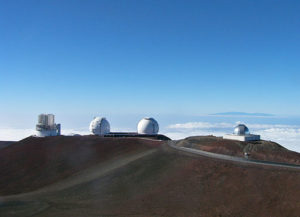
Image: View of part of the Mauna Kea Observatory, Hawai’i. Visible is the Subaru Telescope, the two telescopes of the W. M. Keck Observatory, and the NASA Infrared Telescope Facility (IRTF). Image contributed by Sasquatch (Own work) at Wikimedia Commons
Japan’s Subaru optical telescope played a critical role in tracking the 2015 repeated Fast Radio Bursts.
The importance of international cooperation was obvious to astronomers interested in planning for future discoveries of Fast Radio Bursts. The first FRB had been discovered in 2007, the second in 2012, and in 2015, a series of FRBs occurred which caused a team of astronomers and scientists to work together to corroborate and pinpoint (hopefully) a source of the FRBs.
So, on April 18, 2015, the Australian 64-meter Parkes Radio Telescope detected an FRB flash and immediately notified the collaboration. Within 2 hours, the CSIRO Compact Array telescope, located 400 kilometers (250 miles) north of Parkes, slewed in the direction of where the pulse was spotted and was able to detect a radio emission from the blast site which lasted for 6 days before fading. Already astronomers had done something unprecedented; they had identified the location of a FRB and measured its radio afterglow.
Meanwhile, atop Mauna Kea in Hawaii, the Subaru telescope was able to begin its observing run, identifying the precise source of the FRB and radio afterglow. As the location of the April 18 [2015] FRB was known to a precision of 1,000 times better than previously discovered FRBs, Subaru made the groundbreaking discovery that this FRB originated inside a galaxy 6 billion light-years away.
Tracking the repeated FRBs to their origin sheds light on how matter may be distributed in space.
What is particularly interesting is that, after further observations of this random galaxy, the researcher found it to be an old elliptical galaxy — the kind of galaxy where you wouldn’t expect to see much in the way of star formation. This is the first indication that FRBs probably aren’t generated by star formation processes.
“This is not what we expected,” said Simon Johnston, Head of Astrophysics at CSIRO and a member of the research team. “It might mean that the FRB resulted from, say, two neutron stars colliding rather than anything to do with recent star birth.”
What’s more, this observation was used as a tool to identify how much material the radio emission from the FRB traveled through, eventually reaching Earth 6 billion years later. And for this one event, it seems to exactly match our theoretical models as to the distribution of matter, including dark matter, in the universe.
“The good news is our observations and the model match — we have found the missing matter,” said Evan Keane from the SKA Organisation, and lead author of the study published in the journal Nature. “It’s the first time a fast radio burst has been used to conduct a cosmological measurement.”
Read the source article at news.discovery.com.
